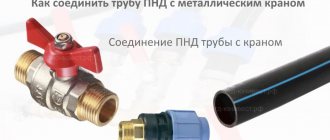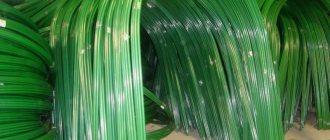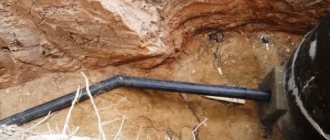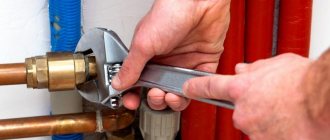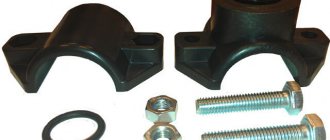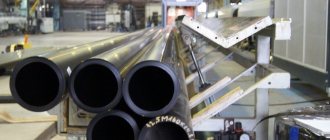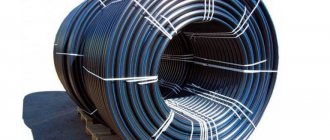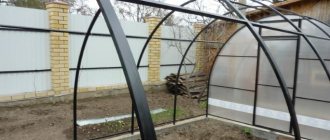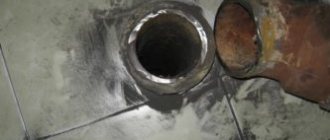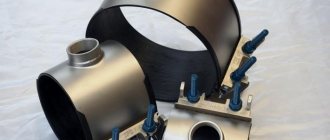One of the common materials used in the manufacture of polymer pipes is low-density polyethylene. This material is available and has a low price. It is used when laying non-pressure sewer networks and pressure water supply systems. Difficulties often arise with straightening such pipes - we will tell you about the most effective methods.
HDPE pipes are flexible and durable, light in weight, so they are easy to work with. Main advantages:
- the material is not subject to rotting or corrosion;
- long service life - at least 50 years;
- do not crack at low temperatures;
- are not afraid of fungi and bacteria;
- environmental Safety;
- can be used when installing water supply systems even in seismically active areas;
- have low cost;
- ease of installation;
- several connection methods - detachable and permanent.
Thanks to this, HDPE pipes are quite common in the construction industry, and they are used to create irrigation systems in agriculture, construction of wells, when laying electrical networks and assembling water pipes. They are often used both in industry and in everyday life when laying pipelines. Alas, they are not used for heating and hot water supply - the temperature of the constantly transported liquid through the pipes cannot be more than +40°C. Although the material can withstand temperatures of more than 100°C, already at 80 degrees it begins to gradually soften.
Methods for straightening polyethylene pipes
Pipes to be transported are wound into coils in the store. Once unwound, they rarely remain straight. Note that the methods for straightening different pipes (HDPE 25, HDPE 35 and HDPE 110) are the same.
The most common methods for straightening a pipe:
- Heating in the sun. Classic heating method. You just need to put the material in the sun and wait until it acquires the desired flexibility.
- Hot water. This solution is an affordable and, most importantly, effective means of bending pipes.
- Construction hairdryer. It is considered a good option because it can quickly heat the pipe to the desired temperature.
- Molding machine. It is used to straighten pipes on an industrial scale. Purchasing such equipment practically for personal use is difficult and not always profitable - only those who often have to straighten pipes will need it.
- Gas-burner. This is a rather dangerous option, since with its help you can not only make the plastic flexible, but also irreversibly damage it.
READ ALSO: Who Solders Copper Heating Pipes
How to align a pipe at home
It’s understandable to level a rod or corner, take a sledgehammer and rivet, but how to level a pipe.
In my practice, I had to straighten bent pipes many times and I always used the same method, namely, I heated the place where the pipe was bent (you can use a blowtorch, in the end just on a fire, coals, etc.) and then quickly stuck it in into a piece of pipe of a slightly larger diameter, which must first be rigidly fixed in a yew, and leveled by pushing it through it. Both cheap and effective. Try it this way. Good luck to you!
Pipes can be different depending on the material they are made from, including metal-plastic pipes and HDPE pipes, steel, copper, aluminum, etc.
Moreover, according to the type of manufacture, steel pipes (if we are talking about them) can be either solid (without a seam) or welded, and this must be taken into account.
A steel pipe can generally be profiled (square, rectangular, etc.) and we do not ignore this.
The pipe diameter and wall thickness are different.
The pipe may be part of a certain product, and there may also be nuances when straightening it.
If we are talking about a metal-plastic pipe, we buy this spring,
Steel pipes are different (see above) and are straightened in different ways, the options are as follows:
On the rail or straightening plate, we place the pipe with the bend upward and through the block we strike with a sledgehammer at the bend, perhaps this will be enough.
There is an option to heat up (with a cutter) the bend and then straighten the pipe, but without haste.
You can pour sand into the pipe, plug the ends (for example, cut a thread and then a female threaded plug), then heat it and straighten it.
Using a vice is also an option if the pipe is not large in diameter and not thick-walled.
To straighten a pipe, using standard methods like a vice, a sledgehammer and brute physical force will not work, since the pipe has the ability to fold or break under very slight repeated loads - that is, it is bent, but when bent back, it can simply turn around at the bend!
Therefore, the only correct option is to only heat it, and not to heat it with a fire or a blowtorch, but with the burner of a gas cutter or gas cutter; only a well-heated pipe until red can be leveled. There is no need to hit the heated pipe with a hammer or sledgehammer (the seams may come apart!), you need to use a lever and the place where the pipe is clamped, by bending it as much as possible to achieve an even result.
The pipe can be inserted, for example, into the holes of the floor slab or something similar; it is very convenient to heat and bend the pipes.
Sometimes, for example, when installing or modernizing a water supply system in rural areas, it becomes necessary to straighten steel pipes. Here are some of the most common methods for performing this procedure.
1. Using chalk, we mark on the surface of the pipe the area that we are going to straighten. We find a suitable horizontal metal plane, ideally a straightening plate. Then we place the pipe on it with the bend up. Using a hand-held impact tool (hammer or sledgehammer) through a wooden spacer, we strike the previously marked convex section of the pipe until it is leveled. The force of the blows should be measured so as not to accidentally deform the product. This method is difficult to implement alone, since the round pipe will rotate under impacts, so someone needs to fix its position. Placing soft material (for example, wood) under the pipe allows you to achieve your goal faster by reducing springiness.
2. We tightly close one end of the pipe with a plug, completely fill the pipe with sand and plug it from the other end. Such preparation is necessary to prevent diameter deformation. Next, we place the pipe under the press so that the bend is on top. Then, using a gas torch (blowtorch), we heat the bend to a bright red color, move the pipe a couple of centimeters further under the press and heat it again. We repeat the sequence of actions until the product is completely straightened.
3. For this method, it is necessary to select a section of another pipe into which the steel profile pipe to be straightened can fit relatively freely. It is best if it is a piece of solid-rolled pipe with thick walls. We firmly clamp it with a bench vice, having previously cleared the inner surface of burrs. We fill the pipe that needs to be straight with sand in the same way as in the previous method. Then we insert a pipe of a smaller diameter into a larger one, place it with its bent place closer to the edge of the segment, heat it with a blowtorch or gas burner and gradually, smoothly press it in the direction opposite to the bend, giving the required shape.
Straightening with a forming machine
Using such industrial equipment, you can quickly bend a large number of pipe blanks. This “pipe straightener” allows you to make straight pipes from coils of the required length and shape, which can be freely used in the future.
This procedure is carried out in stages, since high temperatures can ruin the appearance and functionality of the pipe. Work process:
- A frame is created from fiberboard or chipboard according to the dimensions of the pipe.
- A silicone shell is prepared to secure and protect the pipe.
- The pipe is installed in the shell prepared for it, and it is installed in the frame.
- The resulting structure is mounted in a molding machine.
- The device heats up to 90 degrees.
- The pipe in the apparatus is subjected to pressure and straightened.
- After work, you need to turn off the machine, remove the product from the device and wait until it has cooled completely.
Bending methods
Forming a bend can be done using: a molding machine, a construction electric hair dryer, a hand-held gas torch and hot water.
Method of forming a bend using a pipe bending machine
A forming machine is a device for the industrial method of bending pipes. Making a certain bending radius is carried out in two ways: rolling a roller around a template without filler and winding it onto a template with a mandrel inside the pipe.
When working on pipe bending machines, the following sequence is followed:
- Marking and cutting into blanks.
- Heating the workpiece.
- Bending of workpieces.
- Product cooling.
- End trimming.
For bending on pipe bending machines, it is necessary to observe the ratio of the cross-section of the pipe (S) to the outer diameter (DN):
- for rolling the pipe around the template (S/DH)≥0.065;
- for winding a pipe onto a template (S/DH)≤0.065.
The length of the workpiece is determined by the formula:
where a is the bending angle, degrees;
R – bending radius along the axis, mm;
l – straight section required for joining pipes during welding (l = 2 DН), mm.
After removing the finished product from the template, the bending angle of the HDPE pipes must be increased by 1.2 times due to the presence of elastic deformation.
For all other methods, the bend radius must be equal to 4DN.
When bending a pipe at a standard angle of 30°, 45°, 60°, 90° and condition 4DN, the length of the workpiece is selected according to the table.
Bend angle, degrees
Dependence of workpiece length L on pipe diameter, mm
If the dimensions of the forming machine do not allow heating a HDPE pipe of the required length, bending is performed several times.
The formation time of the product after heating should be minimal, but not more than 40 seconds for pipes made of low-pressure polyethylene with a diameter of up to 90 mm, and 60 seconds for pipes with a diameter of up to 160 mm.
As a rule, molding equipment is installed in specialized enterprises and has a high price.
Forming a bend with a construction electric hair dryer
For this method, it is advisable to make a template from a wooden board of the required bending radius, as shown in the figure.
Sequence of operations when working with a hair dryer:
- Making a template using a jigsaw.
- Marking and cutting pipe blanks.
- Heating the workpiece. For correct bending, the intended segment is evenly heated with an electric heater, turning the workpiece around its axis. The optimal temperature for heating low-pressure polyethylene pipes should be in the range of 140 o C - 160 o C. You cannot bring a hair dryer too close, as strong heating will occur in a small area and possible damage to the pipe.
- Bending of workpieces. The product is formed, as on molding machines: 40 seconds and 60 seconds, respectively. The bending process must be smooth to avoid breaking at the deformation point.
- Product cooling. The bent pipe must be fixed until it cools completely.
- End trimming. Cleaning is carried out using a special and other cutting tool.
If you need to get a small bending radius over a short length (about 1 m), you can do without a template. It is necessary to evenly heat the marked area and, taking the ends of the pipe with your hands, bend it slightly and hold it until it cools completely.
Heating with a manual gas torch
This method is completely similar to the previous one. However, it requires more care during the heating process. An open flame is used here, so you need to very carefully prepare the workplace and follow fire safety measures.
The advantage of this method is the possibility of using the burner away from the power supply. The cost of a cylinder with a propane-butane gas mixture weighing 220 grams is approximately 10 times less than the cost of an average-power electric hair dryer. And the continuous burning time is from 2 to 4.5 hours.
Hot water method
The method involves pouring boiling water over the future bend area. The effectiveness of the method is very low. For pipes with a diameter greater than 50 mm, it is difficult to achieve uniform heating throughout the thickness of the pipe wall and over its surface area. There is also a high chance of getting burned.
For small volumes of work, boiling water from a two-liter electric kettle is enough to heat one section of the HDPE pipe.
On an industrial scale, special baths with a liquid temperature of 135 ° C ± 5 ° C are used.
How to straighten a HDPE pipe with your own hands
When there is neither a hair dryer, nor a gas burner or hot water at hand, HDPE pipes are straightened by placing a heated bulk substance inside them. The method is easy to implement. To do this, you will need to do a number of specific actions:
- Unwind the HDPE pipe from the coil. This can be done with improvised means and/or tools.
- Prepare a mixture of salt or sand in the required condition for work.
- Place in a small bag.
- Place the bag in the oven and set the heating temperature to 100 degrees.
- Remove the bag with the mixture from the oven.
- Fill every meter of pipe with the mixture.
- Wait.
After a certain time, the pipe section becomes more flexible and easier to straighten.
Straightening a pipe under the sun
To straighten a polyethylene pipe, you can simply stretch it, leave it in the sun, and fix the edges. After time, the pipes will straighten themselves, after which they can be laid. Most likely, you will have to wait a long time, but you won’t have to put in any effort.
HDPE leveling using hot water
READ ALSO: Corrugated Pipe Ekoplast HDPE Where It Is Used
This method is often used in production. Coils with pipes are immersed in large containers with hot water (80-90°C), left for a while, after which they are taken out and unwound on a flat surface.
This can be done at home, but it is usually used to align water supply pipes of not too long length with a diameter of up to 50 mm. Using a watering can, pour enough hot water into the pipe so that the pipe is filled.
The most effective and affordable methods at home
Using the methods below, it is easy to straighten pipes at home, but there is a high probability of damaging them if you do not perform the steps carefully.
Gas-burner
It is considered the riskiest heating method, since the workpiece can be quickly burned through. In addition, with powerful heating from a burner, the surface of the HDPE pipe can not only become smoky, but also foam.
Careless use of a gas burner can lead to skin burns. For this reason, it should not be used by those who do not have experience in using it. It is recommended to try using a gas torch to straighten the pipe on a small section of it, preferably a separate one.
A hair dryer is the most affordable method at home
The most accessible method of all involves the use of a hair dryer - the principle of its operation is similar to a conventional hair dryer, the only difference is in the heating temperature. First, the uneven pipe needs to be laid out on a flat surface, then heated with a hairdryer and stretched. It is important to leave it to cool for a while.
Alignment errors
- Overheating of the workpiece. When the temperature rises above 107 degrees, the polyethylene begins to melt and can catch fire.
- Insufficient heating of the HDPE. If the inside does not have time to warm up, the polyethylene becomes brittle and can easily burst when leveled.
At the end it is worth summing up. If you have the opportunity to heat low-pressure polyethylene pipes in the sun, then it is better to use it, as this is the most affordable way. But if you need to straighten long pipes or you don’t have the opportunity to use the sun, then you should use a hair dryer.
The most important thing is to follow safety precautions and the degree of heating, then everything will go efficiently and quickly.
Features of straightening HDPE pipes
The long pipe does not need to be heated completely - you just need to go over the right places with a hairdryer or torch. By leaving the pipe after work for a while, you can maintain strength and increase flexibility.
HDPE pipe is afraid of UV radiation. For this reason, it is better to lay it underground. The pipe is left in the sun only for further straightening.
Installation of HDPE pipes does not require soldering. Instead, special clamp fittings must be used. In terms of connection strength, they are not inferior to soldering.
Characteristics of heating equipment
To bend or straighten an HDPE pipe, you must first heat it. It should be borne in mind that excessive exposure to high temperatures can lead to irreversible deformation of the material. Therefore, the equipment used to soften the polymer must have:
- temperature adjustment to control the heating level of the pipe;
- several operating modes;
- air flow adjustment.
Minimum bending radii for polyethylene pipes
By choosing the right equipment, you can carefully give HDPE pipes the desired configuration and do without the use of fittings and couplings.
Transportation of plastic pipes is possible only in the form of coils or sections of specific sizes. When twisted, the building products resemble rings. It is known that improper handling of plastic leads to its deformation or damage. Therefore, it is very important to understand how to straighten a plastic pipe after bending it without compromising the quality of the material.
Technologies for bending polyethylene products
All known methods of changing the shape of such pipes are based on the main properties of the material from which they are made. The polymer softens under the influence of strong heat and can take the shape we need. This can be done using heating devices:
- Construction electric hair dryer; Special molding machine.
Some craftsmen create homemade devices in the form of a spiral of copper wire, with the help of which they can also achieve deformation of the material. A special tool is also used to cut workpieces to the required length.
HDPE: main characteristics of the material
Low pressure polyethylene is a product obtained by polymerization of ethylene at a pressure of no more than 0.5 MPa and a temperature of about 80°C. Its main advantages are:
- Low thermal conductivity;
- high wear resistance;
- high tensile and compressive strength;
- resistance to aggressive substances;
- resistance to low and high temperatures (from −60°C to +60°C).
GOST 16338-85 requires that HDPE used in the construction of pipeline systems have a density of 0.93 g/cm3, a melting point of 125°C -130°C, bending and cut strength of 19 MPa, moisture absorption of no more than 0.04 %.
HDPE pipes in our catalog
HDPE drinking pipe
HDPE technical pipe
HDPE gas pipe
Compression fittings for HDPE pipes
Properties of polymer materials
Such beautiful properties of polyethylene products as their strength and elasticity appear only under normal temperatures. When it increases to approximately +80 degrees, the polymer material becomes soft and viscous, which is why pipe blanks can be freely bent.
Worth paying attention! This opportunity is based on the production technology of HDPE pipes; during their production, granules of the initial material are melted at a temperature of about +130 degrees.
This suggests that it is possible to level HDPE class pipes (without destroying the base structure) by heating them to slightly lower temperatures. It is necessary to understand that its subsequent increase can lead to irreversible consequences (to the complete destruction of bonds at the molecular level).
The proposed methods for straightening HDPE blanks are based on the properties described above and allow you to avoid bad consequences.

